Alice Project takes a new trip to Wonderland
May 27, 2010
 His colleagues at Oxford knew him as the Rev. Charles Dodgson, a painfully shy mathematics professor and logician with a stammer and a penchant for photography, chiefly portraits of little girls. But the world knew him as Lewis Carroll, the brilliant fantasist who created “Alice in Wonderland” and “Through the Looking Glass,” immortal works of children’s literature that have been adapted in various forms thousands of times the world over since their first print publications in 1865 and 1871.
His colleagues at Oxford knew him as the Rev. Charles Dodgson, a painfully shy mathematics professor and logician with a stammer and a penchant for photography, chiefly portraits of little girls. But the world knew him as Lewis Carroll, the brilliant fantasist who created “Alice in Wonderland” and “Through the Looking Glass,” immortal works of children’s literature that have been adapted in various forms thousands of times the world over since their first print publications in 1865 and 1871.
Hard on the heels of director Tim Burton’s latest cinematic version, the downtown-based Vesper Theatre Company on Friday, May 28, begins performances of “The Alice Project: An Original Wonderland Experience.” Call it an urban update of Carroll’s classic fable, casting Alice as a saucy waitress and aspiring artist struggling to reconcile her creative ambitions with the mundane demands of paying the rent and earning a living. Playgoers participate through a series of Wonderland-themed rooms and spaces, decorated with original art and populated by performers like a street magician – not traditional theatre “in the round,” but theatre “all around.” Warning: not for very young children – this visit to Wonderland may be a little too rugged for them.
The Alice Project Warehouse is located where Banning St. and Center St. meet at 120 N. Santa Fe Ave. in downtown Los Angeles. Doors open at 7:30 p.m. for an 8:00 p.m. curtain. See Vesper Theatre tickets for dates, prices and ordering, or call the theater at (213) 260-1613 for further information. The show runs through June 27.
Decisions, decisions: a guide for the perplexed voter
May 27, 2010
The June 8 California primary election is just around the corner. With literally dozens of decisions to make on state and local legislative and judicial candidates—not to mention various ballot measures—we thought a little help was in order.
Here are some non-partisan and official government sites that can offer guidance.
L.A. County Bar Judicial Elections Page: A detailed resource guide to the County Bar Association’s judicial ratings, with links to an assortment of other authoritative sources.
League of Women Voters SmartVoter Web Page for L.A. County: For decades the League of Women Voters has been the go-to place for fair, independent and informed analysis of often complex and confusing initiatives and other ballot proposals.
Secretary of State Voter Information Guide: The online version of the official State of California handbook for statewide candidates and state ballot measures.
LAVote: (County site) The LA County Registrar-Recorder’s site for locating your local polling place and looking up your individualized sample ballot, which in addition to the candidates and ballot measures includes candidate qualifications and pro and con local ballot arguments.
Posted 5/27/10
Maestro on a mission
May 27, 2010
A few years ago, a former LAPD commander I knew from my days on the City Council wrote me an interesting letter. It wasn’t about the latest crime-fighting or community policing strategies—at least not in the usual sense of those terms. Instead, he wrote to urge me to keep pushing for musical education and expanded access to classical music in our county. His reason? “I never arrested a youngster who played a musical instrument.”
I viscerally understood what he meant. As a youngster, I was what we call today a “latchkey child.” My mother died when I was 10, and my dad worked afternoons and evenings. Fortunately, in those days we still had musical education in our public schools. When I entered Bancroft Jr. High School in Hollywood, I joined the “Beginning Woodwinds” class and was assigned the oboe, one of the most difficult instruments in the orchestra. For three years I religiously rehearsed at school and practiced at home.
That oboe was a loaner, but I got to keep something important: an unforgettable educational experience that not only broadened my cultural horizons but also, as I now realize, kept me out of trouble.
All of this came back to me on Saturday afternoon, when I went to the Walt Disney Concert Hall to watch Gustavo Dudamel conduct Youth Orchestra Los Angeles (YOLA). This is a music education program undertaken by the Los Angeles Philharmonic and inspired by Venezuela’s legendary El Sistema, which produced Dudamel.
El Sistema–created in 1975 by the visionary Dr. Jose Antonio Abreu, who still oversees it–has placed musical instruments in the hands of hundreds of thousands of Venezuelan youth and created orchestras in all of the country’s major cities, and many of the smaller ones as well. It’s more than a musical exercise; it’s an incredibly powerful social program with an international message that’s going viral. The best of the El Sistema musicians make up the internationally acclaimed Simon Bolivar Orchestra, which tours the world and last year thrilled Los Angeles audiences at Disney Hall.
Now, with Dudamel as the Philharmonic’s Music Director, the El Sistema-style program started here in 2007 is on the verge of great things. YOLA now has 300 participants who observe a rigorous practice and rehearsal schedule after school. While the program here was intentionally started slowly, its growth is imminent and inevitable.
I first heard the orchestra last summer, and while they struggled with the music, you had to love the kids and their enthusiasm. They’ve come a long way since then. These kids have already played the Hollywood Bowl, and can now they can say that they’ve made it to Disney Hall, too.
The orchestra members–a sea of red, yellow, green, purple and blue T-shirts—took their places Saturday on the internationally-famed stage before an audience of about 1,000 family, friends and orchestra supporters. Their rehearsal with Dudamel was the closing event in a three-day symposium called “Composing Change: YOLA and the El Sistema Movement.”
Even playing hurt, having pulled a neck muscle earlier in the week, Dudamel exuded an infectious warmth and humor from the moment he stepped onstage. He started out by not just shaking the hand of the young concertmaster, but also patting his head.
Their first piece of business—going over a difficult minor key march from Mahler’s First Symphony—gave way to an enthusiastic rendition of the main theme from “Star Wars” and, finally, to a fun and rousing reading of “Chamambo.”
It was an unforgettable hour for these kids, who represent every ethnic and racial group in L.A. Every hour they spend practicing, they learn the value of hard work and team work. What a life lesson: that by working together and subordinating their own urges, they can produce great music. (Some of our political leaders could stand to learn that lesson, too.) And, from the social policy point of view, every hour the kids spend with the orchestra or practicing at home is an hour they are not susceptible to the vicissitudes of growing up in today’s urban America.
YOLA is just getting started. It’s no El Sistema—yet–but the journey has begun. Dudamel closed the rehearsal by praising the kids for “giving the message and music of our people and our continent. How? Because they have an instrument in their hands.”
And that’s worth a round of applause from all of us in Los Angeles.
For more on YOLA, check out the Philharmonic’s website, and read our earlier story about the orchestra here.
Here’s a video look at Youth Orchestra Los Angeles:
http://www.hollywoodbowl.com/media/video/flv/yola_103.flv
Posted 5-10-10
Helping veterans, one berry at a time
May 27, 2010
Strawberry Flag is a living work of art. It’s also a social experiment, an adventure in aquaponic gardening, a village green, a place to ride a power-generating exercise bike, to silkscreen a T-shirt, to sample a raw food lunch—or to simply sit in a tent, sipping tea while nibbling an old-fashioned biscuit with hand-crafted jam.
Most powerfully of all, it’s a place where human beings are finding that great sustenance comes in small berries.
“To get to dig in the ground for me is a pleasure. To be close to the ground—to me, that’s close to God,” says Bobby Shelton, 75, an Army veteran who served in the Korean War and now is seeing action on the front lines of Strawberry Flag.
The experimental art installation on the grounds of the Veterans Administration campus in West Los Angeles is the brainchild of artist Lauren Bon, who, together with Dr. Jonathan Sherin of the VA, saw the possibility of creating a grand and evolving work on the site. The project is being funded by the Annenberg Foundation, by way of Bon’s Metabolic Studio.
Nestled on an all-but-forgotten quad on the VA grounds, the flag is made up of seven “stripes” of strawberries. The berries were rescued from an abandoned field in Rosemead and are now growing in pots set into white piping. Recycled and filtered L.A. River water pumps through the pipes, powered by a row of stationary bikes hooked up to batteries. At the top of the installation, light pours through cut-out stars onto a blue field, creating a restful shaded area.
Shelton’s specialty is tending to the ailing plants in the strawberry nursery. He’s got a life-giving touch; a thriving vegetable garden near the strawberries is a point of pride.
“It’s a wonderful project,” says Shelton, who takes the bus from his home near Inglewood to work at the flag six days a week. “I’ll be riding back and forth, telling people about it.”
Shelton does his job as part of the VA’s “compensated work therapy” program. So does Mel Williams, 59, an Air Force veteran who’s in charge of the onsite “vermiculture”—the process of using worms and their waste to create a compost tea that helps plants grow.
Williams has a two-hour commute to work each way from San Pedro, but you won’t hear any complaints.
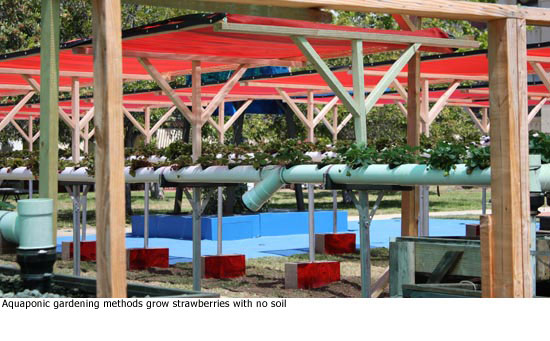 “I love this,” he says. “I’m being enriched with a lot of things here. I wake up and look forward to it…It gives me time to ponder what’s next.”
“I love this,” he says. “I’m being enriched with a lot of things here. I wake up and look forward to it…It gives me time to ponder what’s next.”
Bon, who lives in Topanga Canyon, said she was moved to create Strawberry Flag after the election of Barack Obama created an “imperative for the rest of us to rise to the occasion.”
“It makes sense to redefine what it means to be a patriot,” she says, “by growing a strawberry flag in the midst of under purposed buildings in the center of historic West Los Angeles.”
The artist, granddaughter of Walter Annenberg and a trustee of the Annenberg Foundation, is known for other works including Not A Cornfield near Chinatown in downtown L.A., in which she transformed an “industrial brownfield” into a cornfield. She’s also currently at work on a film project about the Owens Valley called “Silver and Water.”
Her land-use agreement with the VA ends in September. But she hopes to see some kind of continuing presence on the site that will keep the spirit of Strawberry Flag alive after she leaves.
Since it started last June, the project has grown quickly and organically.
There’s a Strawberry Flag Internet radio station, with programs put together in the gleaming Airstream trailer (also reclaimed and recycled) that serves as an on-site office. (A neon sign on the side of the trailer reads: GRAB A MOP.) A monthly newspaper, the Strawberry Gazette, is about to come out with its fourth issue. Strawberry Flag’s YouTube channel features a video chronicle of the project’s evolution.
The nearby VA buildings are being touched by the project’s vitality, too.
“It was a very different place when we came here last year,” says Rochelle Fabb, the project manager. “It was like a cemetery.”
One of the buildings now houses the project’s light-filled and inviting kitchen space. It’s where vets like Ruth Harris, Gregory Gauthier and Julio Espino work with newly-hired chef Gabriella Salamon, a raw food and healthy eating specialist, to learn the ins and outs of working with food grown on the site.
On Tuesdays, the kitchen serves up a healthy lunch after a “boot camp” workout on the stationary bikes. Wednesday afternoons are devoted to “jam sessions”—turning the strawberries and other fruits into preserves that are now proudly arrayed on shelves in the kitchen. Tea is served weekdays at 3 p.m., with a special High Tea offered once a month. (The next one is scheduled for 4 p.m. on June 10. Check Strawberry Flag’s Facebook page to RSVP.)
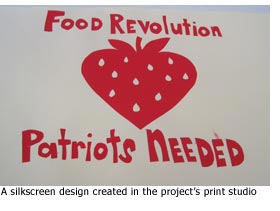 In another nearby building, Larry Flaherty and Ray Rodgers preside over the print studio. Lining the table are vibrant silkscreen patterns that were transferred to T-shirts during a workshop. The studio also offers sessions in print-making and landscape painting to veterans, many of them first-time artists.
In another nearby building, Larry Flaherty and Ray Rodgers preside over the print studio. Lining the table are vibrant silkscreen patterns that were transferred to T-shirts during a workshop. The studio also offers sessions in print-making and landscape painting to veterans, many of them first-time artists.
“I thought it was magic when I saw what they could do with colors,” Flaherty says.
Rodgers points to their program’s “therapeutic value.” “I personally have gained people skills,” he says.
While Strawberry Flag is intended primarily for vets, it’s also open to the public, who are welcome to take part in any of the activities. (A map is here.)
On Monday, a Memorial Day drum circle is scheduled at the site from 7 p.m. to 8 p.m. to remember those who have served.
“If you have a drum, bring it,” Fabb says. If not, “we’ll have plenty of things here to bang.”
Sherin, the chief of mental health at the West Los Angeles VA campus who helped come up with the concept with “fellow Topangan” Bon, sees in Strawberry Flag a powerful metaphor for the veterans under his care.
“Strawberry plants provided a service. They were pulled out of the ground, retrieved and brought to this healing ground…The whole time this is happening, the veterans are doing the exact same thing—literally. Tending to [the strawberries] is quite a therapeutic experience.”
He, too, hopes that Strawberry Flag can live on in some form.
“”Innovative projects that engage the vets and involve a VA-community partnership are absolutely the wave of the future,” Sherin says. “I feel that our facility can capitalize on the innovative model, the raw energy at the ground level, and can continue along these lines with a project that continues many of these things in an enduring manner.”
For now, the flag is an attraction—and a curiosity—for many of those making their way around the sprawling VA grounds. And for those who work there, it’s an ongoing passion and commitment to a rich circle of interconnected lives.
“It’s about the strawberries,” says Williams, as he tends the worms that nourish the crop that makes the jam they serve to his fellow veterans at teatime. “We have to keep the strawberries healthy.”
Posted 5/27/10
More L.A. beaches acing their tests
May 27, 2010
The grades are in, and water quality at Los Angeles County beaches improved significantly last year, according to environmental watchdog Heal the Bay’s statewide 2009-10 Beach Report Card.
 The latest report, released this week, gives 79 percent of the county’s beaches an A or B grade during the dry-weather summer season, up significantly from last year’s 70 percent and from the six-year average of 73 percent. The report uses a complex scorecard based on weekly measurements of bacterial pollution between March 2009 and April 2010 at 326 California beaches, including 86 in L.A. County.
The latest report, released this week, gives 79 percent of the county’s beaches an A or B grade during the dry-weather summer season, up significantly from last year’s 70 percent and from the six-year average of 73 percent. The report uses a complex scorecard based on weekly measurements of bacterial pollution between March 2009 and April 2010 at 326 California beaches, including 86 in L.A. County.
Heal the Bay President Mark Gold says the improved grades are the result of efforts to clean up water runoff from streams and storm drains. “These pollution cleanup projects are beginning to pay dividends,” he said.
Failing grades at two troubled Malibu beaches last year jumped to B’s this time, thanks to recently-installed cleanup systems. A county Department of Public Works project at Marie Canyon launched in late 2007 zaps bacteria-tainted water with ultra-violet radiation before returning it to the creek that empties into the ocean at Puerco Beach. At Paradise Cove, the cleaner flows correspond with the completion of new privately-owned sewer and waste water treatment systems.
Despite the good news, Los Angeles County’s overall water quality remains the worst in California. Seven local beaches earned an F in year-round testing—down from 15 last year, but still troubling, Gold said.
Five local beaches made the group’s “Beach Bummers” list of the worst summer-season spots. The bummers include beaches at Avalon Harbor Beach on Catalina; Cabrillo Beach in San Pedro; Santa Monica Pier; Colorado Lagoon in Long Beach; and Sunset Boulevard and Pacific Coast Highway in Pacific Palisades.
Even with cleaner beaches, Gold counsels swimmers to stay out of water near creek mouths or storm drains. “If it’s an open-ocean beach, it’s a clean beach,” Gold said.
For Heal the Bay’s press release on L.A. region beaches, click here.
Posted 5/27/10
Taking the bus to your place in the sun
May 26, 2010
Beachgoers, L.A. County would like to take you for a ride.
Whether you’re heading from Warner Center to Will Rogers State Beach or from City Terrace to the Santa Monica Pier, there’s a bus to take you to the ocean this summer.
The first of the buses start running on Memorial Day weekend, although most will begin service in mid- to late-June.
The cost ranges from free (Playa Vista/Marina del Rey/Venice Beach shuttle) to 50 cents (for a one-way trip on the Topanga Canyon beach bus) to $6 (a roundtrip ride from the Antelope Valley to Santa Monica.) Riders under 12 must be accompanied by an adult.
The first bus out of the gate this summer will be the free Beach Shuttle that runs from Playa Vista to Marina del Rey and Venice Beach, which will operate on Fridays, weekends, and holidays between Memorial Day Weekend and Labor Day. Its first day of operation is this Friday, May 28. The shuttle bus, which runs on environmentally-friendly compressed natural gas, also will stop at Burton Chace Park’s summer concerts on select Thursday nights. (Those seeking another fun, alternative mode of transportation this summer can also check out the WaterBus, which charges $1 each way to transport patrons to the Marina del Rey summer concert series.)
Also getting off to an early start is the Antelope Valley Summer Beach Bus, which begins service on Memorial Day, May 31. After that, it will run on Tuesdays, Thursdays, Saturdays and on Labor Day.
The Topanga Canyon Summer Beach Bus starts operating June 21, and will operate Monday through Saturday through Sept. 6. It runs from Warner Center (convenient to the Orange Line) with two stops in the Valley and four in Topanga Canyon before delivering patrons to three choice waterfront destinations: Topanga State Beach, Will Rogers State Beach and Santa Monica State Beach.
The county also offers beach-bound summer buses from Altadena, Charter Oak/Duarte, East Los Angeles, La Crescenta/ La Canada Flintridge and Castaic/West Ranch.
And just because they call them beach buses doesn’t mean passengers have to hit the sand.
Catrina Love, a senior marketing analyst at the county Department of Beaches and Harbors, notes that the shuttles provide transportation for all sorts of summer plans.
“The shuttle means that you don’t always have to take your car just to get around,” Love says. “You can always get off along the route for other activities.”
Posted 5/26/10
At LACMA, a new gallery stirs to life
May 26, 2010
The fences are coming down and the invitations are going out—clear signs that a new era in the “transformation” of the Los Angeles County Museum of Art is just months away.
Workers can now be seen putting the final touches on the new Lynda and Stewart Resnick Exhibition Pavilion, a striking 45,000 square-foot gallery by Italian architect Renzo Piano, who also designed the neighboring Broad Contemporary Art Museum.
Meanwhile, 3,000 elaborate invitations featuring a small, silvery Venetian mask with feathers began arriving this week for a gala fundraiser on September 25 to celebrate the Resnick gallery’s “unmasking.”
Guests, who’ll pay from $2,500 a ticket to $100,000 per table to help fund LACMA’s special exhibitions, will be the first to tour the building and its three inaugural exhibits, which include highlights from the Resnicks’ collection and displays of ancient Mexican sculpture and European fashion from 1700 to 1915.
The gallery is scheduled to open to the general public on October 2.
The new gallery was built thanks to a $45 million gift made by the Resnicks in 2008.
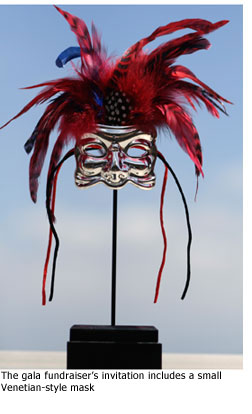 Stewart Resnick is CEO of the Roll Corporation, an L.A.-based holding company that owns extensive tree farms and companies that include Teleflora, Fiji Water and POM Wonderful. Lynda Resnick, the marketing guru behind POM’s iconic curvy bottles, has served as a LACMA trustee since 1992. She designed and donated the unusual invitations for the gallery that carries her name.
Stewart Resnick is CEO of the Roll Corporation, an L.A.-based holding company that owns extensive tree farms and companies that include Teleflora, Fiji Water and POM Wonderful. Lynda Resnick, the marketing guru behind POM’s iconic curvy bottles, has served as a LACMA trustee since 1992. She designed and donated the unusual invitations for the gallery that carries her name.
Initially, the Resnicks were going to donate $25 million for a new grand entrance to LACMA. But when the oil company, BP, offered to fund the entrance, the Resnicks said they’d donate nearly twice as much for construction of the new exhibition hall. The couple also pledged to donate $10 million for art.
The architect, Piano, designed the expansive one-story gallery as a complement to his earlier LACMA work directly to the south, the three-story Broad, which opened in 2008.
The similarities between the two buildings are obvious—travertine-clad walls topped by a skylight-covered roof topped with iconic “fins.” Taken together, the two buildings help create a more unified look on a campus where, until now, each building has differed dramatically from its neighbors.
“You can start to see with the Resnick Pavilion almost complete that the idea was not really to make a building but to make a place,” Piano told a sold-out audience at a “director’s series” conversation with LACMA Director Michael Govan in late April.
The exteriors of both buildings also contain dramatic accents of “Renzo Red,” a signature bright scarlet that the Italian favors. At the Broad, he uses red for the exterior stair cases and escalators. At the Resnick, he uses it on the heating and air conditioning systems, which are visible on the building’s exterior, only recently coming into full view when fencing was removed.
With those fences down, visitors also can now see more of artist Robert Irwin’s “Palm Garden,” the last stage of which is near the Resnick Pavilion. Irwin, who also designed the Getty Center’s garden, began his work at LACMA in 2008 with landscape architect Paul Comstock. Some of the palms are planted in rows, while others are set individually in oxidized steel planters. Between them are lush green lawns.
Already, the garden is exerting a strong pull on visitors.
“It’s such an inviting space,” Eryn Talevich, who was leading a toddler art class at LACMA on a recent Sunday, noted admiringly. “It makes you want to lie down and enjoy the sun.”
For an early review by Los Angeles Times architecture critic Christopher Hawthorne, click here.
Posted 5/26/10
Gunmen confront “lucky” health workers
May 26, 2010
The two L.A. County mental health workers felt confident there was little potential for violence lurking inside the Gardena apartment where they’d been dispatched to evaluate a man who, according to his mother, was “acting bizarre.”
As always, before even arriving, they’d assessed the risks.
“Does the patient know we’re coming?” they asked the mom, who had called the Department of Mental Health’s crisis line. “Has he been hospitalized before? Does he get violent? Has he hurt anyone today? Is he suicidal? Homicidal?”
The answers to these questions and others convinced them that, while the man was manic and “hyper religious,” he probably was not dangerous.
What Jimmey Loya and Shawn Kim could not have foreseen at that moment was that the real danger was bearing down on them from the outside and that their bipolar patient would, strangely enough, be the one to save the day.
On Tuesday, Loya and Kim, who are members of one of the county’s Psychiatric Mobile Response Teams, were praised by the Board of Supervisors for their professionalism and cool headedness during a harrowing, March 29 home-invasion robbery by three gunmen. Supervisor Mark Ridley-Thomas, in whose district the events occurred, called the mental health workers heroic.
Both men, who’ve been employed by the county for less than a year, say the incident illustrates the unpredictable and largely invisible nature of their work. Not a day goes by, they say, that they don’t feel lucky to be alive.
Loya and Kim say they arrived in Gardena at about 6 p.m. Loya, 34, is a registered nurse. Kim, 29, is a psychiatric social worker. As part of a multi-disciplinary team, it’s their job to determine whether patients require immediate hospitalization or should be referred to outpatient services. With each call, the teams enter a universe of uncertainties.
In this case, the pair had been dispatched to a second-floor apartment in an industrial area of Gardena with a reputation for gang activity. When the door opened, the patient said simply: “Come on in. Let’s get this over with.” Arrayed behind him was his support system—his mom, dad, uncle and aunt. 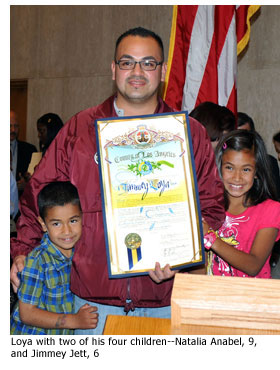
Loya and Kim quickly sized-up the place, looking again for dangers and ways to make their visit safer. They made sure, for example, that all the lights were on. They looked for weapons and kept the front door wide open so that they’d have a fast escape should something go wrong. They then all took a seat around a dining room table, except for the aunt, who stood behind her nephew.
Loya and Kim soon concluded that the patient did not meet the criteria for involuntary hospitalization. He was denying any homicidal or suicidal thoughts. He was not hallucinating. He was loud but not hostile. He was polite and approachable—although that behavior was about to dramatically change.
As the mental health workers were providing the patient with a referral to Harbor/UCLA medical center, three men brandishing handguns burst into the apartment through the open front door.
“Nobody move!” they shouted. “Take everything out of your pockets and place it on the table!”
“I can’t believe this is happening,” the aunt exclaimed. “Is this for real?”
Kim, for his part, was praying that their patient would remain calm and not escalate the situation. “Of course, that didn’t end up happening,” he says.
Instead, the patient suddenly shouted: “How dare you come in here with two officers in my house!” Kim and Loya say their hearts sank. They now feared that the gunmen might kill them in a mistaken belief they were cops. “We’re definitely dead,” Kim thought to himself. “No way we’re going to get out of this anymore.”
The gunmen moved more menacingly toward the mental health workers. “I could feel the gun on the back of my head,” Loya says. “I could feel the barrel. I knew I was going to die.” Loya says he thought about his four young children, the oldest of them 9. But he says he knew that, with a mom who’s a nurse practioner and a sizable life insurance policy to collect, “they were going to be OK. I accepted death.”
The patient was in a different state of mind. He jumped up out of his chair, ripped off his shirt and ran straight toward the armed invaders, screaming, “Kill me! Kill me! Kill me!” The gunmen, startled, headed for the door and then down the stairs, chased by the muscular patient.
“When our client got up, I thought we were doomed. But it caught them by surprise,” Kim says of the robbers. “They didn’t expect anything like that. It didn’t seem they were ready to kill anybody. We were very fortunate.”
When the patient strode back into the apartment, he shouted: “That’s the power of God! If I would have died today, I would have gone to heaven.” He then looked at the county workers and said, “Do you think I have a problem now with my anger?”
“On the contrary,” Loya says he responded. “you’re my hero.”
Loya and Kim say that, as you might expect, their bosses in the Department of Mental Health have been especially attuned to potential psychological trauma they may have suffered from the incident, in which no arrests have been made. Both say they returned to work quickly and are doing well.
Loya says that one thing he does differently these days when entering an unfamiliar home is to keep his hand on his BlackBerry with 911 already punched in and ready to send. He says he also has a new response when people ask how he’s doing: “I feel good. And I’m alive.”
Posted 5/26/10
A lifeline for independence 5/20/10
May 21, 2010




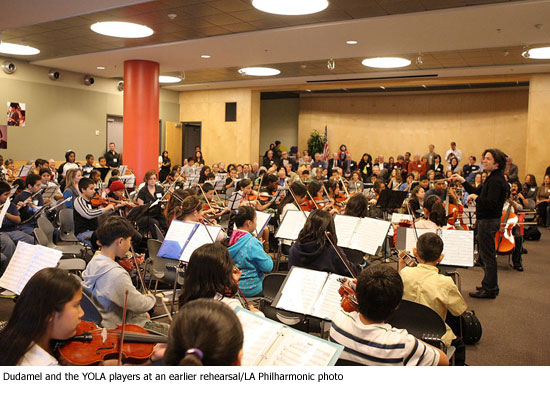
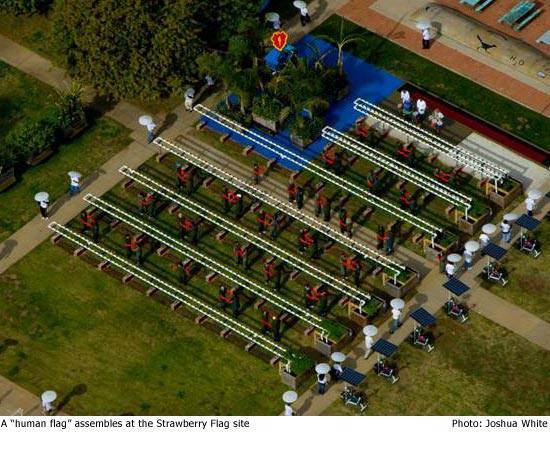








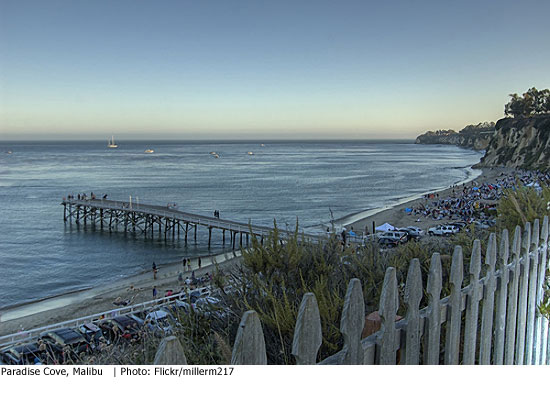
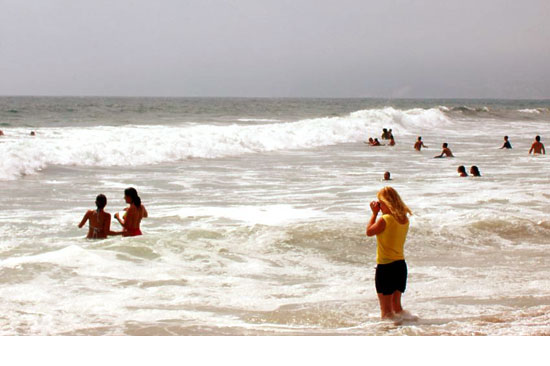
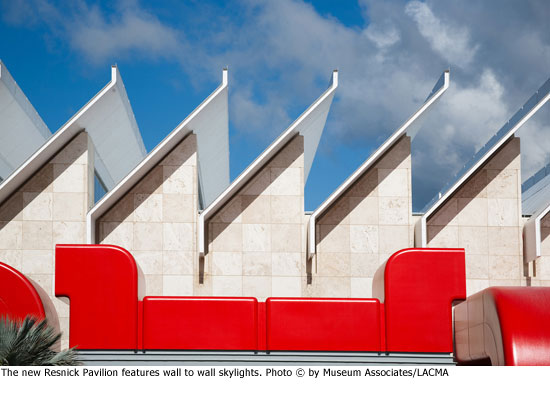
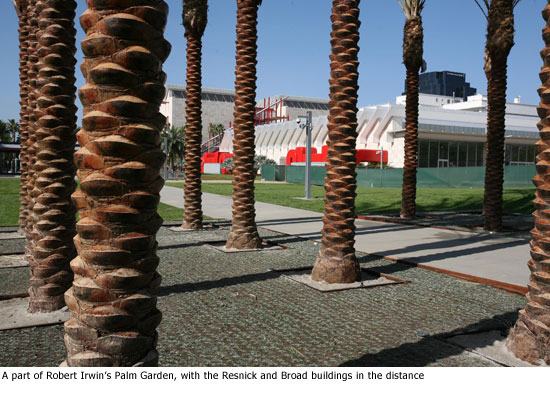
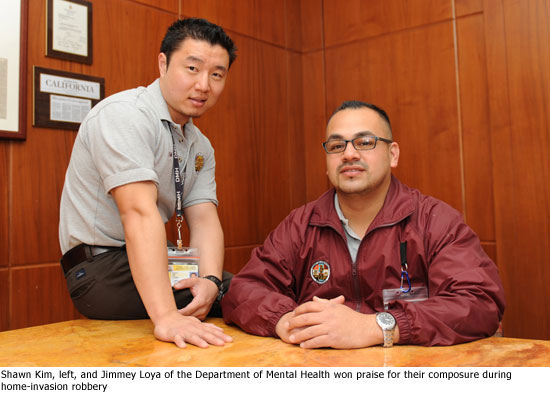
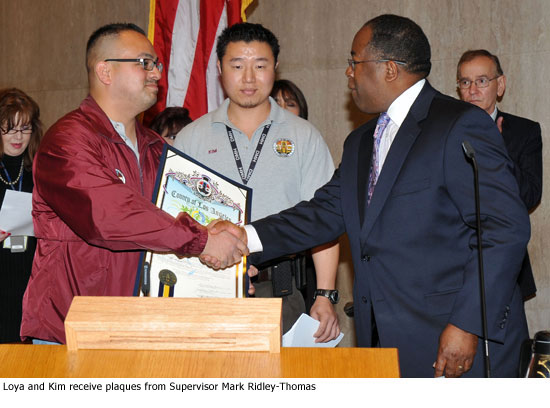






 Check for the latest closure information
Check for the latest closure information








